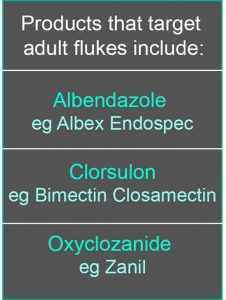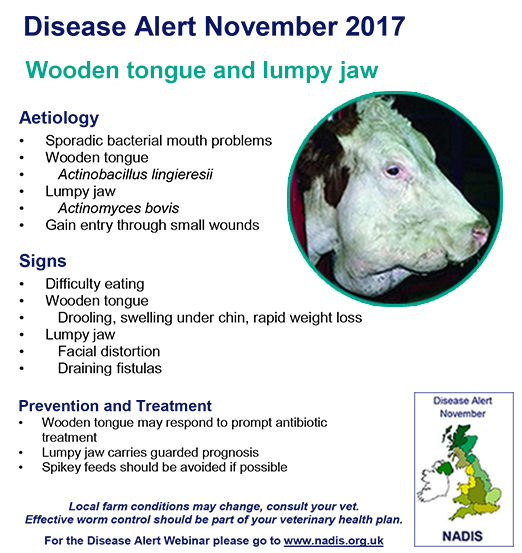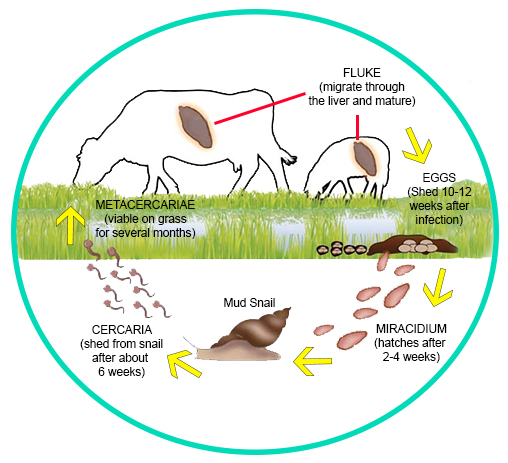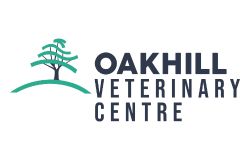
Author: paige_soap
Liver Fluke
 The NADIS liver fluke forecast for the end of 2017 held true with many flocks in Lancashire being exposed to a heavy burden of fluke.
The NADIS liver fluke forecast for the end of 2017 held true with many flocks in Lancashire being exposed to a heavy burden of fluke.
Both acute fluke and sub- acute fluke were prevalent so treatments administered were targeting immature fluke. The products used were either triclabendazole and/or closantel and/or nitroxanil depending on the flocks’ history. While these products are very effective, repeated use will inevitably increase the risk of resistance, to the active ingredient.
To limit resistance, other flukicidal products should be considered, now that the main risk period is coming to an end. Paddocks grazed over the autumn and winter will now carry a much lower burden of the infective metacercariae so treatments can be targeted at the adult flukes (Chronic fluke) that have survived. Targeting the adult fluke at this time of year will reduce the number of fluke eggs shed onto pasture before the mud snails become active.
If you would like anymore information, please contact us.
Overweight Horses
This year, given our mild, wet summer & autumn months, many of ‘good doers’ are coming into winter overweight.
It is of paramount importance that these horses/ponies do not come out of Winter carrying even more weight! We want these horses to have achieved a ‘normal body condition score’ prior to turn out on Spring grass. Overweight equids should ideally be fed good quality hay as this is less calorific than haylage.
We should aim to feed 1.5% of body weight in kilograms of hay, weighed dry, per day. Hay can be soaked for ideally 8-12 hours before feeding to reduce the non-structural carbohydrate load. If feeding soaked hay, a low-calorie vitamin/mineral balancer should also be fed. Remember any dietary changes should be made gradually over a 2-week period to try prevent gastrointestinal upset. Furthermore, overweight horses/ponies should not be over-rugged. Unclipped, overweight horses/ ponies not in work, do not need rugging!
On the flip side of the coin some horses, especially our older patients, can struggle to maintain condition in winter. These patients should have regular dental checks performed as well as being subscribed to a veterinary devised worming programme.
Furthermore, such patients benefit from an increased plane of nutrition as well as adequate rugging. Blood tests including ‘Cushing’s’ bloods should also be considered in such patients.
If you’re worried about your horse’s weight, please contact us.
Overweight horses : Health concerns
Horses come in all sorts of different shapes and sizes, and like humans they can gain weight, which can lead to other health issue.
Obesity in the horse world is as common a problem as it is in the human one, with the weight gains occurring when a horse’s nutritional intake exceeds his physical output. Basically, if your horse is eating more than he’s burning off, he’ll get fat.
All horses, whether ridden or not, stabled or living out, will need to have their diet, health and exercise managed in accordance with their type and workload to ensure they maintain a healthy weight.
Overweight horses are prone to developing various health problems including chronic laminitis, oxidative stress and a less than perfect interaction between insulin and blood glucose. While obesity itself may not directly cause these problems, it certainly has some relationship to the metabolic processes that keep body tissues and systems healthy.
Furthermore, the excess weight a horse carries leads to heat stress, strain on joints and connective tissues and reduced levels of performance.
It’s a good idea to check your horse’s weight regularly either using weigh tape, or if you’re on our Equine Care Plan Premium, you’ll have access to our weight bridge to accurately measure your horse’s weight.
If you’re concerned about your horse’s weight or unsure of what weight they should be, please contact us and one of our vets will be able to assist and advise you.
Anti-freeze poisoning in pets
As the weather gets colder many of us will use anti-freeze in our car engines, but while it’s convenient for us, it’s also very dangerous to our pets.
While many people may think, ‘why would my cat or dog go near anti-freeze?’ well, Ethylene glycol- the main ingredient in most anti-freeze brands has an inviting aroma and sweet flavour. Its appealing smell and taste often tempts animal into tasting it.
Anti-freeze is found in car radiators and some screen washes, but it is extremely toxic to both dogs and cats. As our pets like drinking from ditches, puddles and ponds, it could mean they’re prone to drinking water contaminated with anti-freeze. Anti-freeze can also be found in some inks and snow globes.
The active ingredient of many anti-freezes, ethylene glycol, is rapidly absorbed into the body after drinking. Within hours it causes severe kidney damage, which is very difficult to treat. In one report involving 25 cat cases, 96% of those affected died.
Signs & Symptoms
Some common signs of antifreeze poisoning in dogs and cats include:
- Drunken behaviour
- Euphoria/Delirium
- Wobbly, uncoordinated movement
- Nausea/Vomiting
- Excessive urination
- Diarrhoea
- Rapid heart beat
- Depression
- Weakness
- Seizures/Convulsions/Shaking tremors
- Fainting
Treatment
If you suspect your pet has drunk some anti-freeze, it’s important you contact us ASAP. If your cat or dog is treated immediately after exposure it has a far greater chance of survival. However your pet will need intensive treatment. Tragically, the survival rate is very low if the kidneys have been damaged and poisoned pets often have to be put to sleep.
Prevention
Anti-freeze is one of the most life-threatening poisonings that vets see, but there is a safer alternative. Propylene glycol anti-freeze is more expensive but safe for pets and other wildlife. All anti-freeze products should be labelled to show its contents, so please check these before purchasing and avoid products with Ethylene glycol.
Pet Blood Bank – Saturday 6th January

Canine Donor Programme
Similar to the human blood service, dog owners kindly register their much loved canine companions to give blood at one of The Pet Blood Bank’s many sessions across the country.
After each session, the blood is taken to our processing centre in Loughborough where it is separated into red blood cells and plasma products, and then stored ready for despatch.
The Pet Blood Bank UK run an average of five sessions a week at veterinary practices and kennels, with over 8,000 lifesaving donors registered with the charity. Last year, we sent out over 5,000 units of blood and as transfusion medicine advances, the demand continues to grow.
Every unit of blood can help save four other lives, saving thousands of lives every year.
At Oakhill Veterinary Centre, we support the work the Pet Blood Bank does and we offer our veterinary centre at Goosnargh as a venue. Our next blood bank session will be on Saturday 6th January and we need more owners to bring in their dogs for this great cause.
To get involved, please register your dog using the Pet Blood Bank’s online form, then a member of their team will be in touch to confirm your details and discuss arranging your first appointment. After this, they will send out a Donor Information Pack which includes a Consent Form and a Donor Health Check Form. Please complete these and bring them with you to your appointment along with your dog’s vaccination record.
When you come along to a Pet Blood Bank UK (PBB) donation session, you will be greeted by the staff who are hosting the session. They work on an appointment system, much like your veterinary practice and be given an appointment time convenient to you beforehand.
Your appointment is split into two parts:
- Health and suitability check with their fully qualified vet
They will go through the following process with your dog prior to any donation going ahead:
- Undertake a physical examination of your dog and take its health history
- Carefully clip and clean two small areas of your dog’s neck
- Take a small blood sample and run some tests to ensure that your dog is fit to donate
- Microchip your dog if it is not already microchipped
- Donation
If your dog passes the initial checks, you will be shown to the donation area where a fully qualified phlebotomist will collect about 450ml of your dog’s blood.
After donating, we’ll ask you to stay at the donation venue for a small amount of time to allow your lifesaver to have a drink, something to eat and to be observed by our team. Your dog will receive a goody bag which includes an “I’m a Lifesaver” bandana and tag to thank them. They will also get to pick out a toy to take home and we’ll take their picture for their Facebook and Twitter pages!
You are then ready to go home. They advise that dogs rest for the remainder of the day and can go back to their normal routine the following day.
In total, you should allow around 45 minutes for your appointment, although the actual donation process only takes between 5 and 10 minutes.
If you can’t find a donation session near you, please continue to register your dog as The Pet Blood Bank are hoping to hold sessions all over the UK. They need a minimum of 30-40 dogs to be registered for them to hold a session, so please tell your friends to consider registering their canine companion as well so we can hold a session in your area.
We would like to thank the Doggy Dream Team for providing us with the infographic.
Image creative license to DoggyDreamTeam ©
Keeping chocolate out of reach this Christmas
Christmas is a time where chocolate isn’t usually in short supply and with it being a very busy season, it’s easy to get swept up in the occasion and often forget about leaving advent calendars and chocolate treats lying around, but if your pet does manage to get hold of some chocolate it can endanger their health, sometimes seriously, and even innocent treats can be deadly.
The reason chocolate is poisonous is because it contains a chemical called theobromine and while we usually focus on dogs due to their appetites and their amazing ability to steal food, please note that this chemical is not only poisonous to dogs, but is also poisonous to other animals such as cats, rodents and rabbits.
Although any chocolate should be kept out of reach of your pets, it’s important to note that the darker and more expensive chocolate usually contains more theobromine, which can make the fancier chocolate more poisonous. Although white chocolate contains less theobromine and is less likely to cause chocolate poisoning, it’s still very fatty and can still make your pet ill.
If any of your pets do eat some chocolate, depending on their size and the amount they’ve consumed, initial signs and symptoms can be vomiting and diarrhoea. Chocolate is also a stimulant and can lead to your pet to become excitable, as well as developing muscle twitching, tremors, fitting and life threatening problems with their heart and severe cases can be fatal.
Over the Christmas period make sure that all chocolate is out of the reach, this includes chocolate decorations hung from your tree, advent calendars, boxes of chocolate put out on Christmas day, and one that many people forget is the wrapped chocolates under the tree (most pets have a great sense of smell and can easily get into these chocolate treats).
Although chocolate wrappers are not poisonous, they can cause an obstruction in the gut if eaten. This can be very dangerous and may require surgical intervention. Signs of an obstruction may include vomiting, lethargy, your pet being off their food, not defecating or finding it difficult to defecate.
If you think your pet has eaten some chocolate, please contact us for advice about what to do next.
NADIS- Disease Alert: Farm
Wooden tongue and Lumpy jaw are both sporadic causes of mouth problems in cattle which may be associated with feeding stalky hay.

wooden tongue lumpy jaw
New product – Eprinex Multi
New product – Eprinex Multi is a pour on wormer for beef and dairy cattle, sheep and goats.
Eprinex® Multi 5mg/ml Pour-on for Beef and Dairy Cattle, Sheep and Goats – the first licensed zero-milk-withdrawal pour-on wormer to be made available to sheep and goat dairy producers, and allows dairy animals to be treated at the optimal time without the risk of lost milk.
Eprinex Multi contains eprinomectin and is effective against the adult stages of the major gutworm species affecting sheep and goats, and the lungworm Dictyocaulus filaria. Recent research has shown that treatment can also overcome the productivity impact of a parasite burden, with dairy ewes showing a significant increase in milk yield following treatment with Eprinex Multi compared to untreated animals.
The productivity impact of parasites is well characterised in both species; a study which looked at interactions between nutrition and gastrointestinal parasites in French dairy goats concluded that subclinical parasite infections induced a persistent decrease in milk yield, ranging from 2.5 to 10%. These studies highlight the production benefits of an effective worm control program.
To find out more about this product, please contact us.
Liver Fluke
The NADIS Liver Fluke forecast uses veterinary surveillance combined with weather reports to predict the risk of disease over the coming months. ‘There was an increase in diagnoses of liver fluke disease at the start of this year and the risk of acute fluke is forecast to be high in some parts of North West England and North Wales. It is therefore likely, that treatment for acute fluke will be necessary during October on farms in these regions, especially where there is a history of liver fluke disease.’
Fasciolosis is a common parasitic disease of both cattle and sheep in the UK, caused by Fasciola hepatica and is estimated to cost the cattle industry £23 million annually.
In cattle, infection is more commonly encountered in beef cows grazing poor wet pasture but disease can be seen in dairy cattle especially after summering cattle, most likely bulling heifers, away from home on infested pastures.

Life cycle
The life cycle involves a snail host whose activity and availability require adequate moisture and a suitable ambient temperature during the summer months. Recent wet summers (2015) have been ideal for this complicated fluke lifecycle by supporting large numbers of snails in wet habitats. Cerceriae are released from snails between August and October which develop- into the infective metacercariae, which can survive on pasture for several months to infect grazing cattle.
Clinical Signs
Dairy Cows – In severe chronic infestations, dairy cows show reduced milk yields and poor fertility together with excessive weight loss. Many show chronic diarrhoea.
Beef Cows – The clinical signs are similar to those encountered in dairy cows but can be especially severe in spring-calving beef cows where liver fluke exacerbates the metabolic demands of advanced pregnancy in cattle on marginal winter rations. This results in the birth of weakly calves to cows with little milk, causing high perinatal losses. Severely affected cows may become debilitated with an increased incidence of metabolic and infectious diseases at calving.
Twin-bearing cows show the most severe signs due to the high demands of two foetuses. Unlike infestation in sheep, peripheral oedema is a less common finding with chronic fasciolosis in cattle. Severe infections may cause anaemia.
Bulls – Infested bulls show similar clinical signs as cows such as chronic weight loss and diarrhoea.
Fattening cattle – UK slaughter plants are reporting increasing numbers of liver condemnations due to fluke damage in 12 to 18 month-old fattening cattle where reduced live-weight gains were not suspected by producers presumably due to low-moderate infestation levels.
Sheep
Signs of acute fluke disease
- Sheep with acute fluke infestation may simply be found dead without prior signs of illness therefore it is important to have all sudden deaths investigated to allow immediate preventive measures.
- Post-mortem examination is essential to establish a diagnosis of acute fluke.
- Less severe clinical signs include reduced grazing, rapid weight loss, weakness, abdominal pain, anaemia, and slow to gather.
Differential Diagnoses
Weight loss and chronic diarrhoea in individual cattle will also be investigated by your veterinary surgeon for paratuberculosis and salmonellosis. Chronic liver fluke and paratuberculosis have been reported in the same animal. Other causes of chronic weight loss in adult beef cows could include other bacterial causes such as pyelonephritis, vegetative endocarditis, chronic mastitis, and chronic suppurative pneumonia.
Inadequate nutrition generally presents as a whole group/herd problem of poor production and weight loss during the late winter months in beef herds with diarrhoea an uncommon finding unless poor quality silage is fed.
Fluke Control Measures
- Liver fluke disease can be largely controlled by effective drugs administered at the correct time as part of the flock health plan.
- Wherever possible, reduce the risk of fluke infection by keeping sheep away from potentially contaminated, poorly-drained areas of the farm.
- Triclabendazole (TCBZ) is the drug of choice in cases of acute fluke disease because it is effective against very young immature fluke stages.
- However, advice will also be needed where TCBZ-resistance has been previously suspected on farms and the effectiveness of fluke treatments monitored.
- The coproantigen ELISA test can be used to monitor TCBZ efficacy two to three weeks after dosing, and farmers should contact their veterinary surgeon for further advice where drug resistance is suspected.
- Later fluke treatments could use closantel or nitroxynil especially if TCBZ- resistance is suspected or proven on the farm.
- Where these drugs are used then accurate dosing is essential as toxicity is possible.
- Also, ensure all lambs are vaccinated against clostridial diseases because migrating flukes predispose to Black disease.
If you’re concerned about Liver Fluke and would like more information, feel free to contact us.
